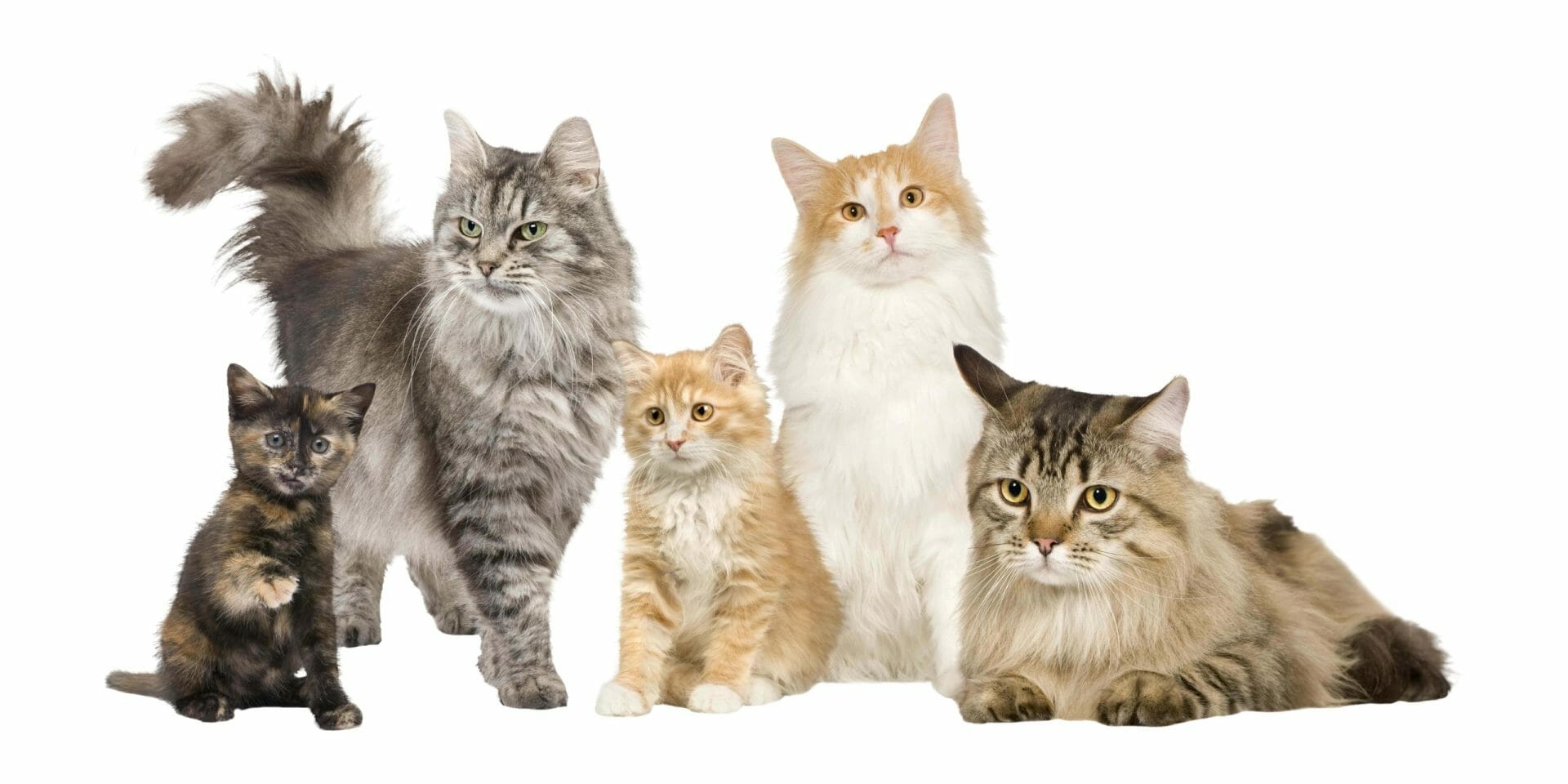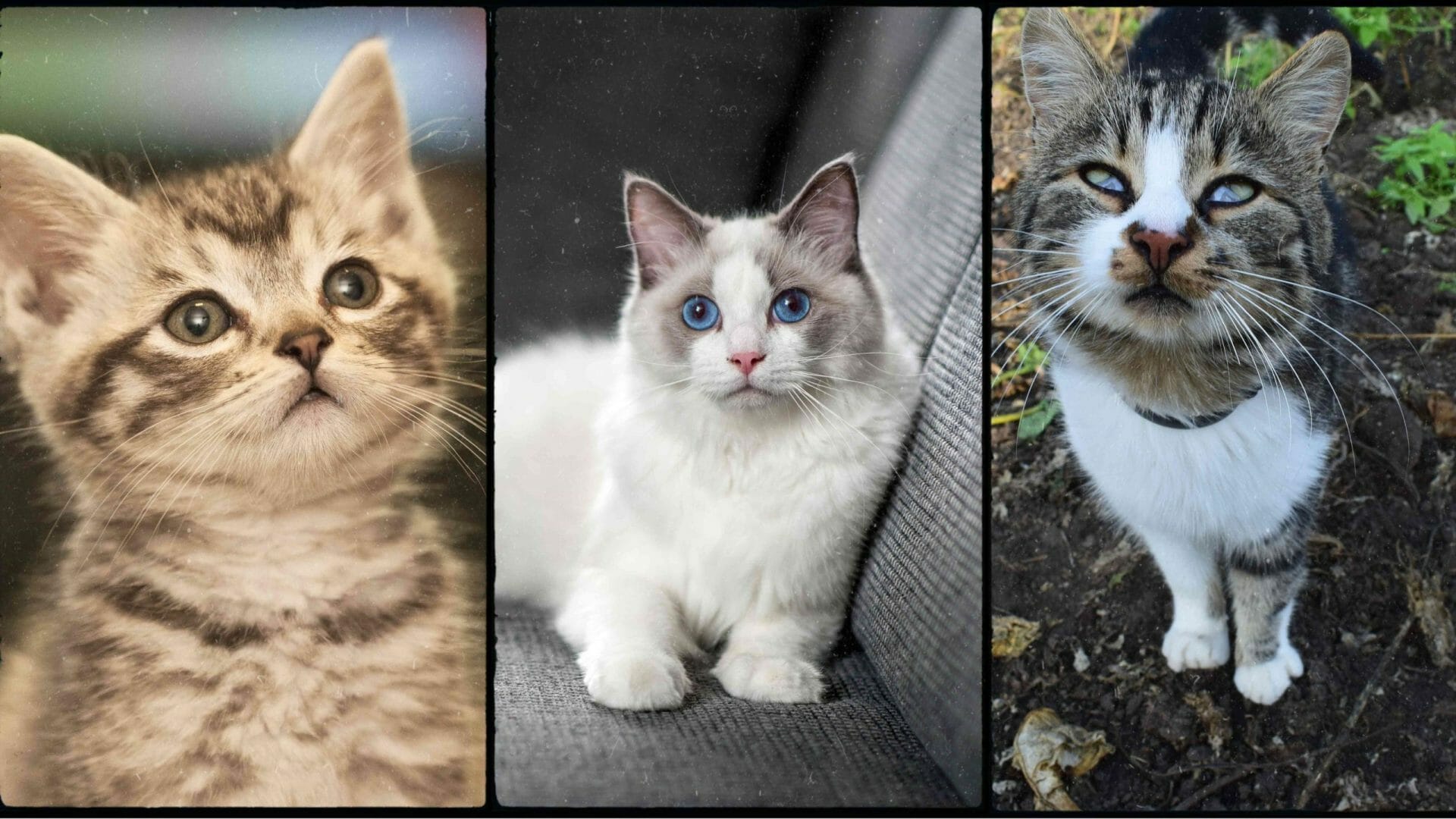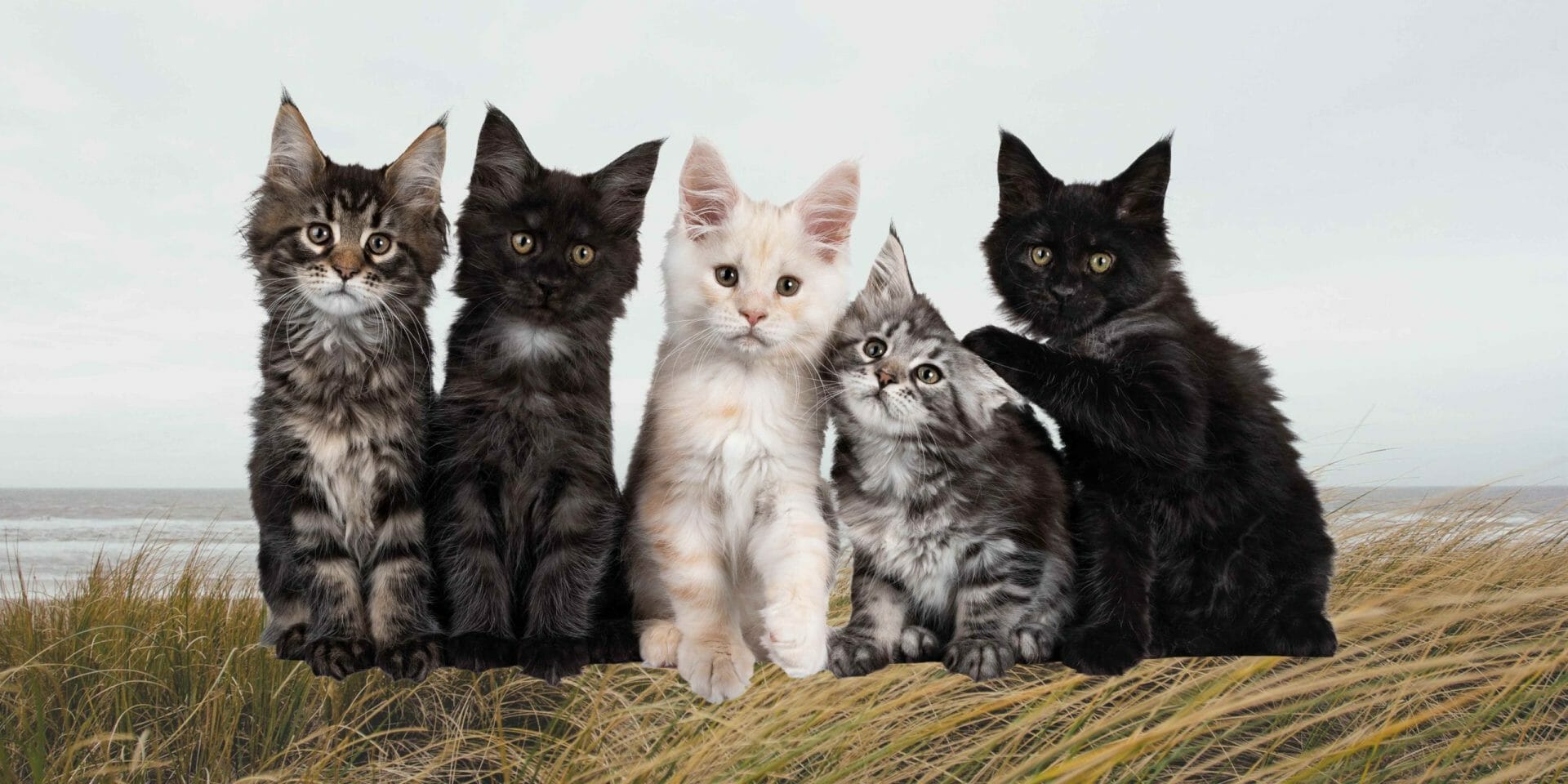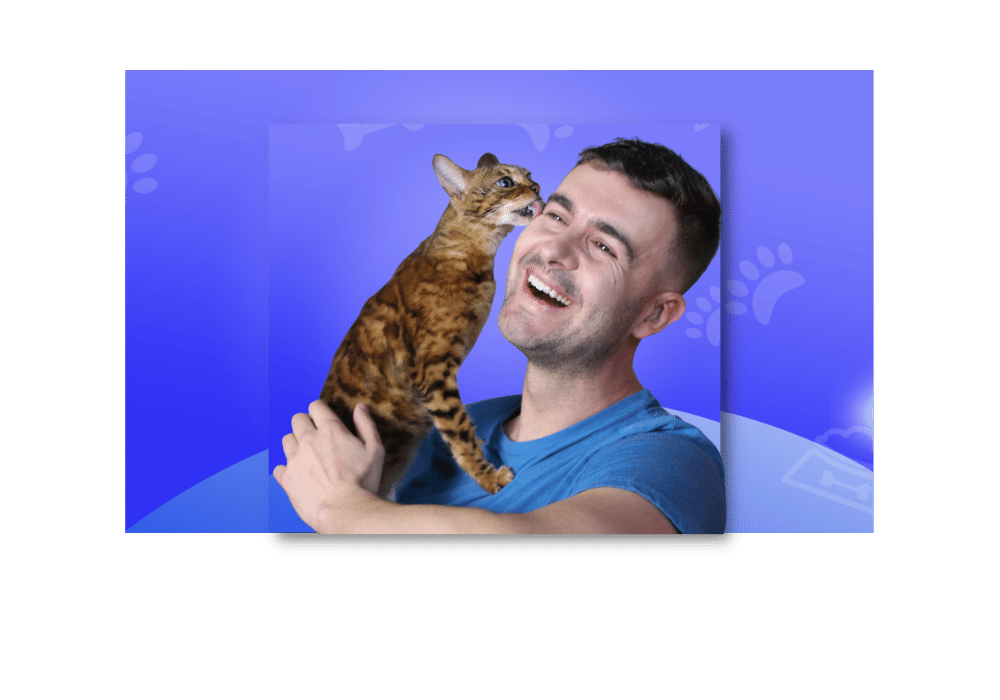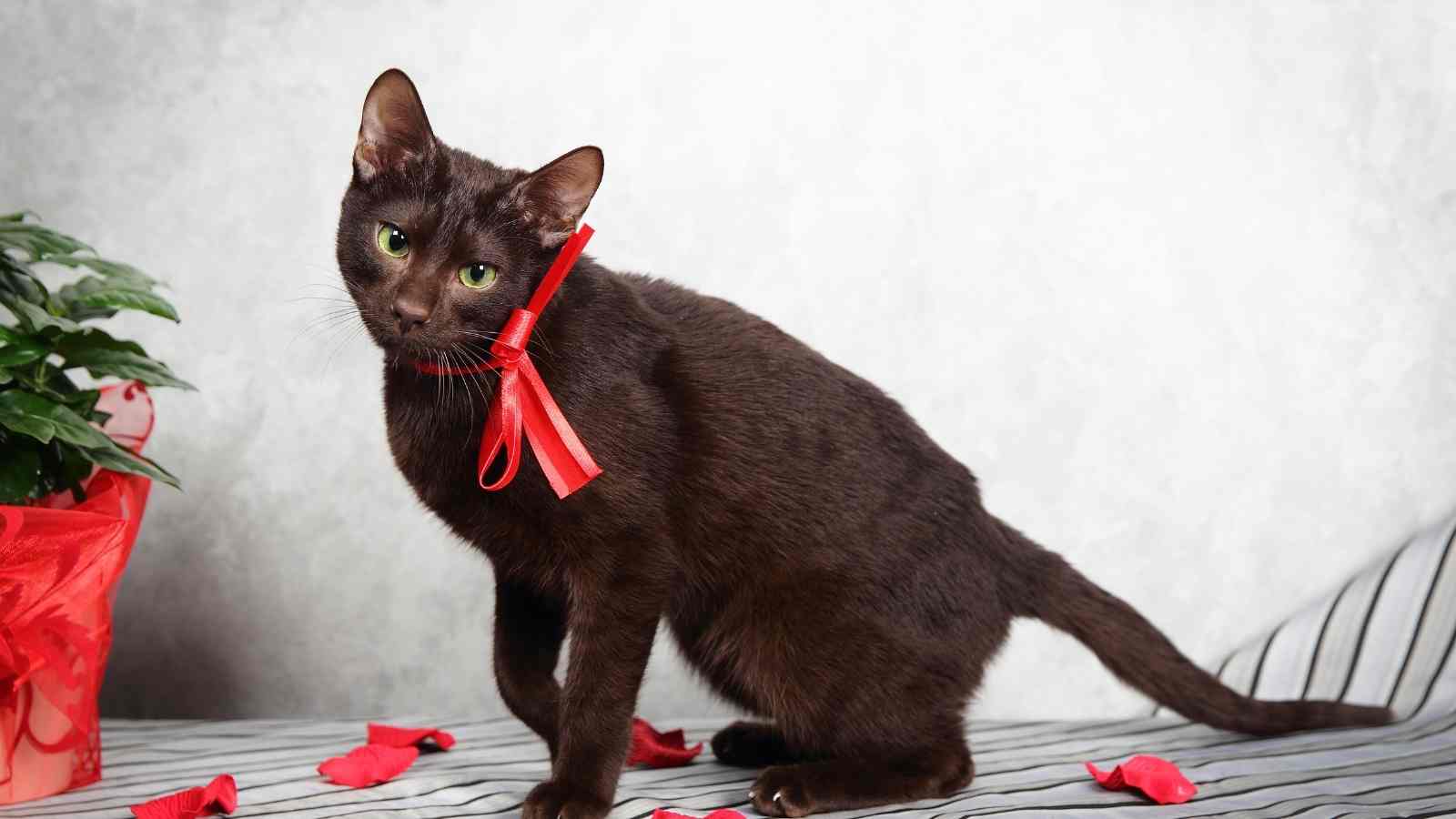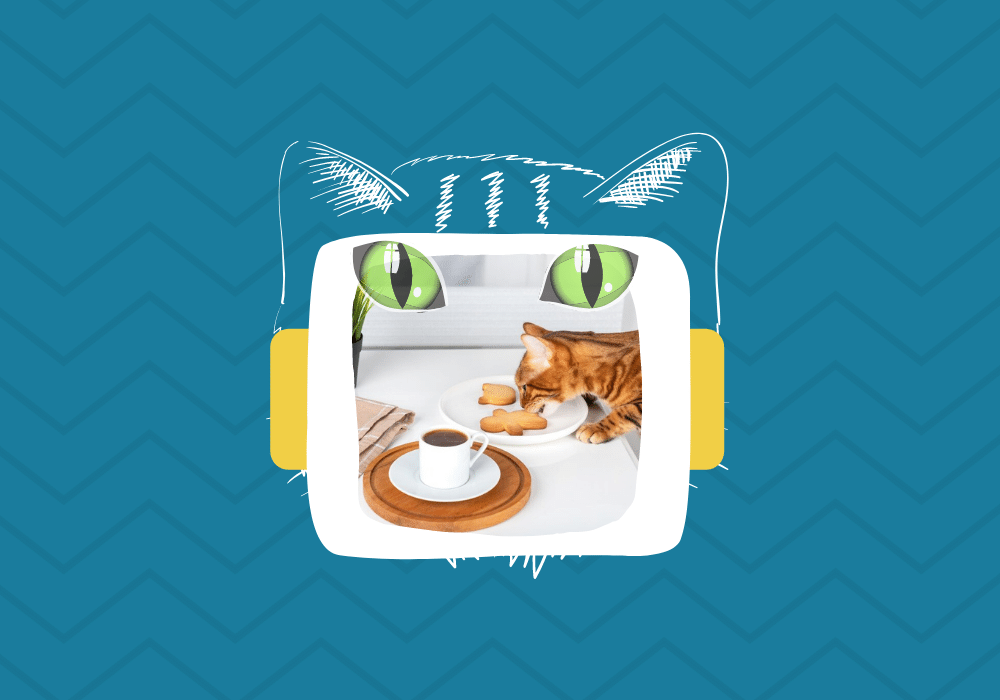22+ Best Grey Cat Breeds You Should Know
The breeds of gray cats stand out for giving felines an elegant appearance and fine style. We will show you the most outstanding ones and their characteristics. If you are planning to adopt a cat of this type, you cannot miss this article.
1. Gray Persian Cat
This breed comes from the Angora cat and is considered one of the oldest breeds.
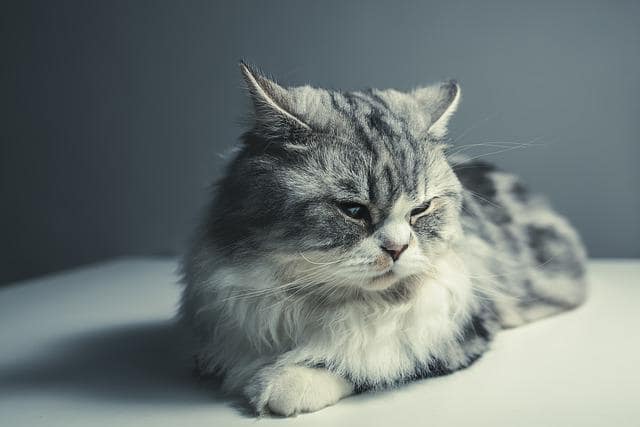
Characteristics
- Origin: Asia.
- Physical features: Large eyes, round and prominent head. Flattened snout and small ears. Short legs and long tail.
- Weight: 3 – 7 kg.
- Life expectancy: 10 – 15 years.
- Size/height: 40 – 50 cm
- Complexion: Robust, medium.
- Hair: Long.
- Weather: Cold.
- Eyes color: Blue, green, coppery, hazelnut. They may also have one eye of a different color from the other.
- Personality: It is an eminently indoor cat since it has been bred to function as a companion animal. It likes to feel accompanied by people, and other animals. It also behaves wonderfully around children if they don’t pull on its hair.
- Health: Respiratory ailments are very common in this breed of cat. Most of these cats will develop polycystic kidney disease. In addition, more than 10% of this type of cat suffers from hypertrophic heart disease, causing sudden death. This ailment generally affects males more than females. You must brush its hair daily.
2. Turkish Angora
You should know that the white Angora is not the only cat of this breed, you can also find it in gray color.
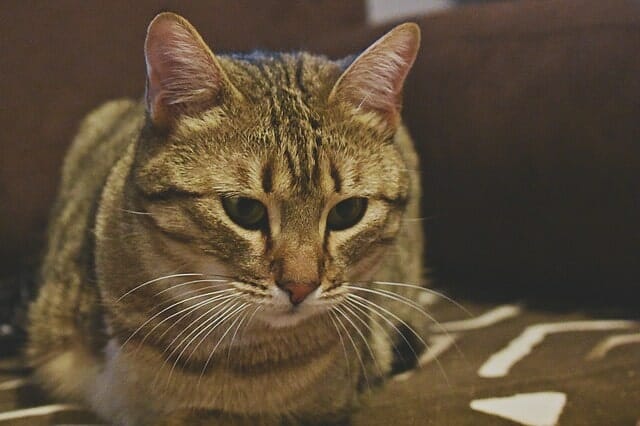
Characteristics
- Origin: Turkish.
- Physical features: Triangular shaped head. Big ears. Fine and hairy tail.
- Weight: 3 – 5 kg.
- Life expectancy: 12 – 16 years.
- Size/height: 20 – 25 cm.
- Complexion: Slim, medium, muscular.
- Hair: Long.
- Weather: They adapt to summer and winter.
- Eyes color: Blue, green, yellow, copper.
- Personality: They are intelligent, affectionate, and sociable cats. They adapt very well to families with children, they like company and are easy to educate. They need to exercise and move continuously, so it is recommended that they have toys and spaces at home in which they can climb.
- Health: They can suffer deafness although it is rare that it appears in gray cats. Heart problems. You must brush it daily.
3. Egyptian Mau Cat
“Mau” means “cat” in Arabic, that’s why it is known as the “Egyptian cat” in addition to its origin.

Characteristics
- Origin: Egypt.
- Physical features: Triangular head, somewhat rounded with gentle curves on the jaw and cheekbones. The ears are large and erect. Large eyes.
- Weight: 3 – 5 kg.
- Life expectancy: 15 – 18 years.
- Size/height: 25 – 30 cm.
- Complexion: Slim, muscular.
- Hair: Short.
- Weather: Summer.
- Eyes color: Green, yellow.
- Personality: They are distrustful of strangers, so it is recommended to socialize them correctly from puppies. They are very active and need space to play. Likewise, they are excellent climbers and hunters. You will have to procure a tree for cats; otherwise, it will take the confidence to jump for your kitchen. It is not a suitable cat if there are small pets at home such as hamsters, rabbits, fish, or birds.
- Health: They can develop breathing problems. The health of the mau cat is somewhat fragile since it does not accept sudden changes in temperature too well, for that reason inside the home we must maintain a stable temperature as far as possible. Sometimes it tends to suffer from obesity; we must control our food and make sure that he exercises regularly.
4. American Shorthair
Everyone loves this breed because it is perfect for any home with kids and other pets.
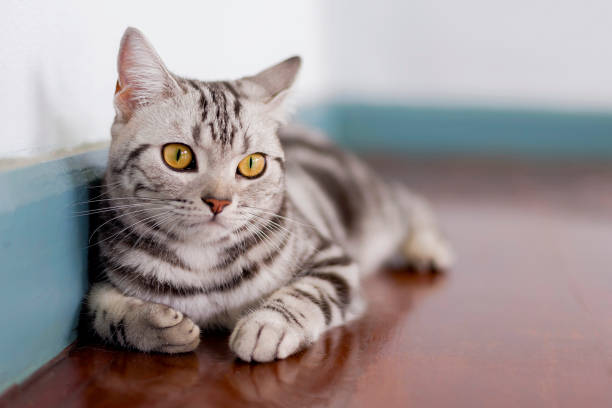
Characteristics
- Origin: America.
- Physical features: Rounded head with prominent cheekbones. Medium and well-separated ears. Large eyes.
- Weight: 4 – 8 kg
- Life expectancy: 15 – 20 years.
- Size/height: 25 – 35 cm.
- Complexion: Muscular, robust, and strong.
- Hair: Short.
- Weather: Temperate.
- Eyes color: Blue, copper, green, gold, hazel, and odd-eyed.
- Personality: The kittens of this breed are affectionate and ideal to have at home since they have a good relationship with other animals and children. Mischievous, curious, and intelligent, he sometimes needs his moments of solitude. They are quite independent but they also like to play a lot.
- Health: They may have cardiomyopathy for which an annual medical check-up is advisable; if it is not treated they can be paralyzed. They may also have respiratory, eye, and mouth problems.
5. American Wirehair
The American Wirehair is a very peculiar feline and little known outside its native USA. Its main hallmark is precisely its fine, rough, and curly coat. Even his whiskers are curly.

Characteristics
- Origin: America.
- Physical features: Roundhead. Big eyes. Medium size ears.
- Weight: 5 – 7 kg.
- Life expectancy: 12 – 18 years.
- Size/height: 25 – 35 cm.
- Complexion: Muscular, robust, and strong.
- Hair: Short.
- Weather: Temperate.
- Eyes color:
- Personality: American wirehair kittens are known to be extremely affectionate cats. These kittens are extremely alert and intelligent; they love games, especially those that enhance the development of their intellect and abilities. They do not like to be alone. They are good with kids and other animals.
- Health: These cats are healthy although they can develop heart problems. You must be careful not to overfeed it because it can gain weight and develop diabetes and obesity. Take it to their doctor once a year and pay attention to its behavior.
6. European Common Cat
You will find gray or silver European cats with darker stripes, these being very popular.
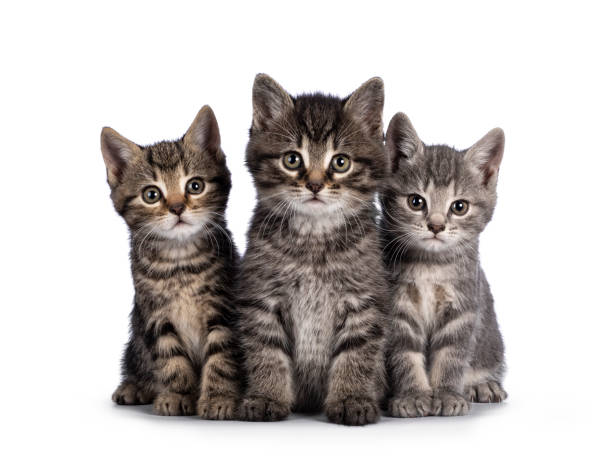
Characteristics
- Origin: Europe.
- Physical features: Ears of medium size and rounded. Rounded eyes. Thick tail. Round and wide face.
- Weight: 3 – 8 kg.
- Life expectancy: 14 – 18 years.
- Size/height: 28 – 35 cm.
- Complexion: Medium, robust.
- Hair: Short.
- Weather: Temperate.
- Eyes color: Green, blue, yellow.
- Personality: Its behavior will depend, to a large extent, on how you raise it: if you fill it with pampering from a young age, it will be a very affectionate cat. They are intelligent, playful, independent, and have a hunting instinct. They tend to be very territorial if they are not socialized from a young age. In these cases, it will be difficult for them to assimilate the arrival of new members to the family, whether they are canines, felines, and even babies.
- Health: They do not have frostbite diseases but they tend to have a urinary, ear, and eye infections and you must help them purge their hairs from the intestine. Take them to a doctor’s visit at least once a year.
7. Nebelung
Its name refers to Nebel which means “fog” in German and is a sociable and lovely breed.
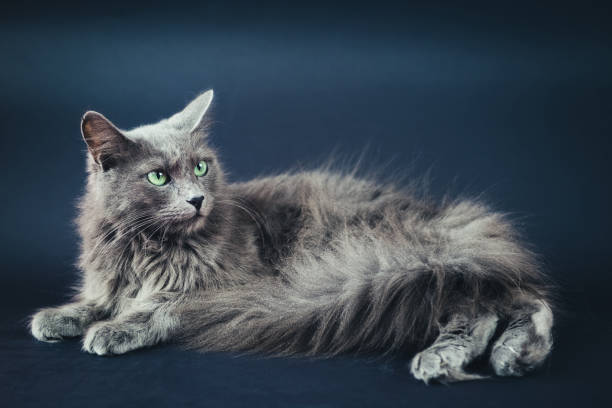
Characteristics
- Origin: America.
- Physical features: Triangular and big head. Large, separated ears. Rounded eyes. Long and very hairy tail.
- Weight: 3 – 6 kg.
- Life expectancy: 15 – 20 years.
- Size/height: 28 – 35 cm.
- Complexion: Strong, robust, and muscular.
- Hair: Long.
- Weather: Temperate.
- Eyes color: Blue, green, yellow.
- Personality: These cats are all joy and love. It will always look for your pampering to feel close to you. They don’t do well spending time alone and can develop anxiety or depression if they feel bored or neglected. If you work all day and you have to leave it alone, it is a bad idea to have it at home. It gets along well with other pets and children.
- Health: It is a strong breed, if you take good care of it with a balanced diet, and daily exercise, you give it love and company and it visits the vet regularly for check-ups, you will be able to enjoy a pet for many, many years without health complications.
8. Russian Blue
The hair of this breed is thick which helped the cat to stand the weather in Russia.
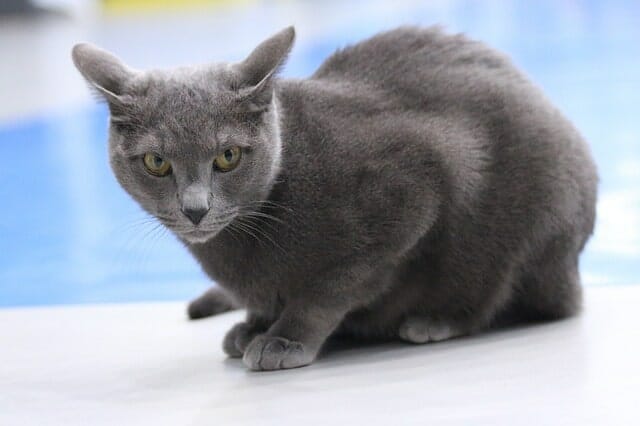
Characteristics
- Origin: Russia.
- Physical features: Longtail and legs, head in the shape of a triangular prism, wide in the area of the eyes. Wide, pointed ears at the top.
- Weight: 3 – 5 kg.
- Life expectancy: 10 – 15 years.
- Size/height: 20 – 25 cm.
- Complexion: Slim, medium, muscular.
- Hair: Short.
- Weather: Cold.
- Eyes color: Green.
- Personality: These cats usually have very strong ties with their family and especially with one of the members. They are calm, affectionate, and very intelligent. They get along well with other pets and children as long as they treat them well. It fits perfectly in apartment living. Loneliness is not a good ally for this breed, which will undoubtedly need a loving and homely family.
- Health: The non-genetic manipulation of this breed explains why there are no known diseases linked to it, being one of the healthiest. However, you must control that they do not develop heart problems.
9. Korat
The Korat cats, originally from Thailand, where are considered carriers of fortune and good luck.
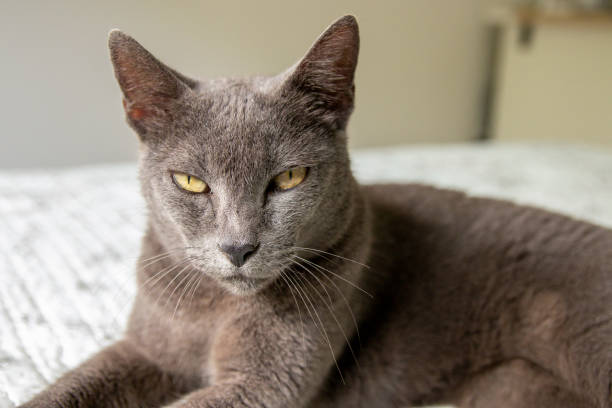
Characteristics
- Origin: Thailand.
- Physical features: Rounded head. Its face is heart-shaped. Big round eyes. The tail of medium and thick length.
- Weight: 2 – 5 kg.
- Life expectancy: 10 – 18 years.
- Size/height: 20 – 35 cm.
- Complexion: Small, muscular.
- Hair: Short, medium.
- Weather: Temperate. They do not like the cold.
- Eyes color: Green although they were born with blue eyes.
- Personality: These cats are very intelligent, calm, playful, and talkative. They treasure a particular and melodic way of purring and meowing when they want to get your attention. They do not tolerate noise and sudden movements, so they are not the ideal pet for families with young children. They like the company of other animals if they are raised together.
- Health: The Korat can have a genetic muscle disease called gangliosidosis, which can appear in 4-month-old puppies and produces severe neurological symptoms.
10. Chartreux
This breed takes more than a year to mature. It is only admissible in a blue-gray hue with orange or copper eyes.

Characteristics
- Origin: Europe although its origin is a bit uncertain.
- Physical features: Trapezoid-shaped head and prominent cheeks simulating a smile. Medium ears, large round eyes.
- Weight: 3 – 8 kg.
- Life expectancy: 12 – 18 years.
- Size/height: 20 – 35 cm.
- Complexion: Big, muscular, and strong.
- Hair: Short, medium.
- Weather: Cold.
- Eyes color: Yellow, copper, orange.
- Personality: They are docile, sweet, and delicate cats. They adapt to almost any environment, as well as to coexist with both children and other animals. As good hunters, it loves games, even creating its own toys with whatever object it can find. They do not like to be alone.
- Health: Its only weaknesses in this regard are knee dislocations or hip dysplasia, motivated by its propensity to obesity. They should eat healthily and exercise so as not to gain weight. They may have ear and mouth problems so they need to be cleaned. Do not forget to take them to a medical check-up on a regular basis.
11. British Shorthair
It is the British national race, although it conquers hearts all over the world.
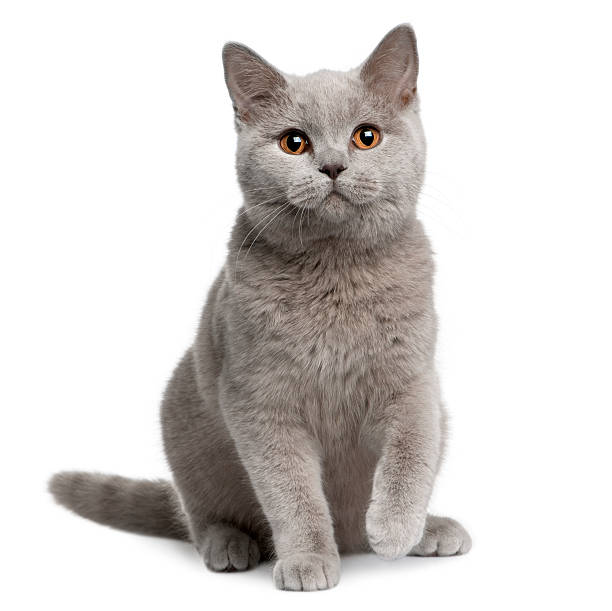
Characteristics
- Origin: Europe.
- Physical features: Round and wide head. Small or medium ears. Round and big eyes. Wide tail.
- Weight: 3 – 8 kg.
- Life expectancy: 10 – 15 years.
- Size/height: 30 – 35 cm.
- Complexion: Big, muscular, and strong.
- Hair: Short.
- Weather: Cold.
- Eyes color: Grey, blue, green, yellow, orange.
- Personality: A sociable, affectionate and friendly cat, they tend to be calm, quiet, and discreet, so they tend to fit in perfectly with other cats, dogs, and even small pets if they are properly socialized as a puppy. It also gets along well with children, due to its friendly and funny character.
- Health: They can present problems in the joints, heart, in kidneys. Regular checkups at the vet and following the recommended vaccination schedule are key to keeping the kitten healthy.
12. lykoi
Its appearance is reminiscent of a wolf and it is one of the newer breeds, in fact, its number is very low worldwide.
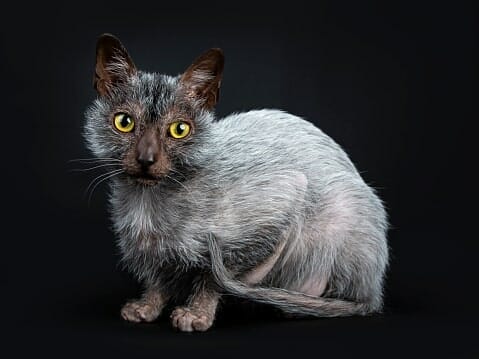
Characteristics
- Origin: America.
- Physical features: Its coat seems to be always messy when they grow up. They are born with very little or no hair in some parts of the body due to a natural genetic mutation. Big ears. Triangular head.
- Weight: 3 – 6 kg.
- Life expectancy: 10 – 15 years.
- Size/height: 25 – 30 cm.
- Complexion: Medium.
- Hair: Short, medium.
- Weather: Temperate.
- Eyes color: Yellow, orange.
- Personality: Although its appearance may seem somewhat fierce, the wolf cat has the normal character of any other domestic feline. Therefore, people who have already lived with some of them describe them as very affectionate, sweet, friendly, playful, happy, very intelligent, and quite active.
- Health: Pathologies inherent to this breed have not yet been identified. Lykoi is, therefore, healthy cats exposed to the typical diseases of the feline species in general. A regular visit to the vet will prevent it from developing any health problems.
13. Munchkin
This short-legged kitten steals people’s hearts with its sweet little face.
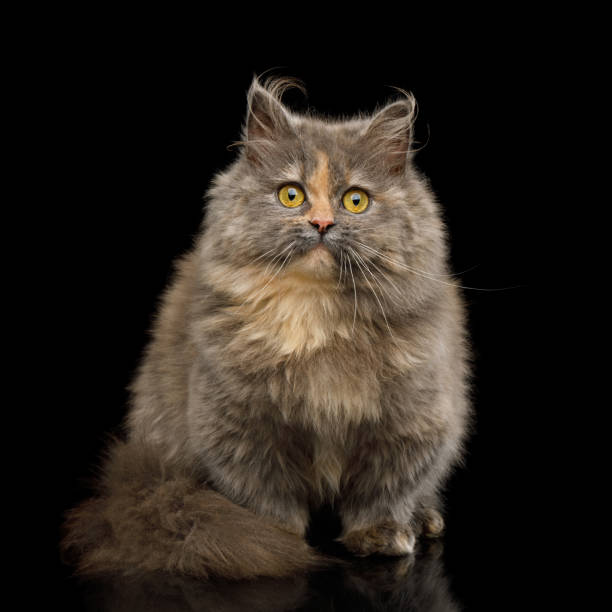
Characteristics
- Origin: America.
- Physical features: Rounded head. Triangular ears, broad-based. Large eyes. Short legs, the hind legs may be larger than the front ones.
- Weight: 2 – 5 kg.
- Life expectancy: 10 – 15 years.
- Size/height: 12 – 17 cm.
- Complexion: Small.
- Hair: Short.
- Weather: Temperate.
- Eyes color: varied.
- Personality: It is a homey, playful, and affectionate cat that adapts perfectly to small spaces and lives happily with children and other pets. Of course, it is not good to spend time alone, so it is not a recommended breed for people who spend little time at home.
- Health: They can suffer from obesity but that is fixed with a balanced diet and daily exercise. They are sensitive to changes in temperature so they can catch a cold. It must have the necessary vaccinations and a regular vet checkup.
14. Siberian
The Siberian cat is one of the so-called “forest cats” since the specimens of this breed spread through the lush groves of Russia and Ukraine.
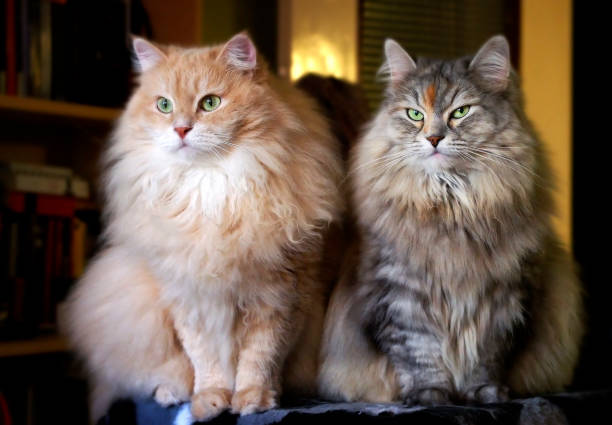
Characteristics
- Origin: America.
- Physical features: Triangular shaped head with rounded contours. Large oblique eyes. Long, hairy tail. Wide and strong legs. Medium and wide ears.
- Weight: 4 – 11 kg.
- Life expectancy: 10 – 20 years.
- Size/height: 20 – 35 cm.
- Complexion: Big, robust, and strong.
- Hair: Medium, long.
- Weather: Cold.
- Eyes color: Blue, green, amber.
- Personality: It is very affectionate, it loves to be brushed and caressed. It is calm, intelligent, curious, and gets along well with children and other pets. It will love to have a cat tree, as it needs to climb and exercise on a daily basis.
- Health: It is a cat with no major diseases of concern. Apart from hypertrophic heart disease, there are no notable pathologies in this breed. Keeping its vaccination calendar up to date and going to a veterinary consultation twice a year is essential.
15. Cornish Rex
These kittens are very characteristic of their wavy hair and their ears.
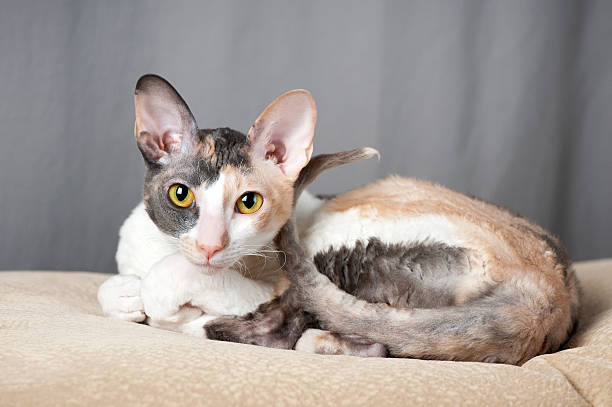
Characteristics
- Origin: Europe.
- Physical features: Her wavy hair. Triangular head. Large, pointed, wide-based ears. Oval eyes. Long and thin tail. Long legs.
- Weight: 2 – 5 kg.
- Life expectancy: 12 – 18 years.
- Size/height: 20 – 30 cm.
- Complexion: Slim, medium, and elongated.
- Hair: Short.
- Weather: Temperate. They do not tolerate cold.
- Eyes color: Varied.
- Personality: They are affectionate, curious, and very playful cats. They do not tolerate loneliness. Don’t be absent for long periods. They get along well with children and other animals. Although they adapt to all spaces easily, they prefer warm indoor environments.
- Health: They are prone to overweight if they do not watch their diet and do not exercise regularly. Their fine hair without a woolly undercoat makes them especially vulnerable to the cold. In this sense, try to avoid cold temperatures at home to prevent colds or respiratory diseases and do not allow it to go outside in the autumn and winter months.
16. Devon Rex
Its big ears and curly or wavy hair are its main hallmarks. It is similar to the previous one but they are considered different breeds.
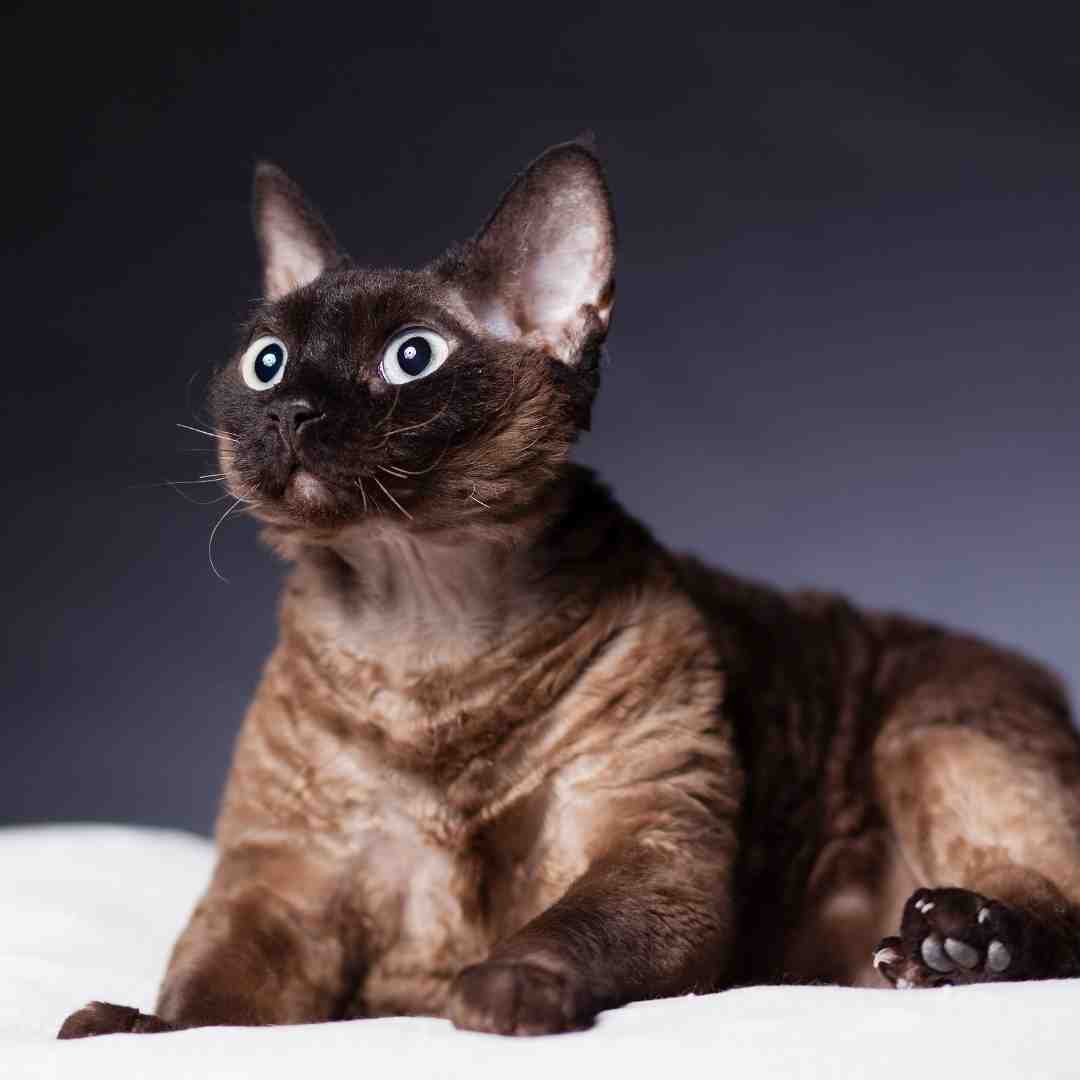
Characteristics
- Origin: Europe.
- Physical features: Her wavy hair. Triangular and small head. Large ears. Oval and big eyes. Long and thin tail. Long legs.
- Weight: 3 – 6 kg.
- Life expectancy: 10 – 15 years.
- Size/height: 25 – 30 cm.
- Complexion: Slim, medium, and elongated.
- Hair: Short.
- Weather: Temperate. They do not tolerate cold.
- Eyes color: Green, blue, yellow, copper, orange, gold.
- Personality: They are fantastic cats in coexistence with children, other cats, or even dogs, as they are very sociable and flexible. They do not tolerate being alone for many hours. They are playful and adorable; they like to have their own toys.
- Health: Ear infection. They are prone to obesity if they don’t exercise and eat properly. Regular veterinary check-ups are strongly recommended to assess and review its general health.
17. Maine Coon
Cats of this breed are large in appearance but very sweet.
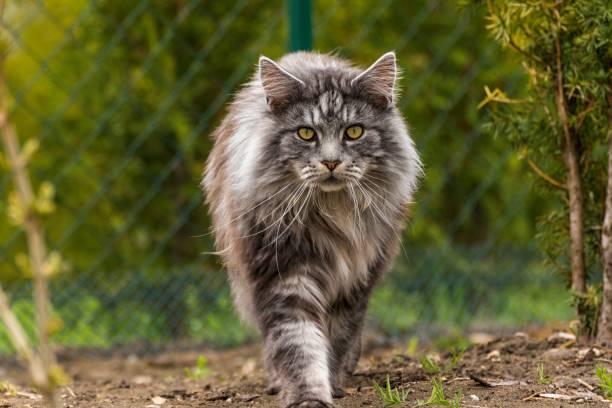
Characteristics
- Origin: America.
- Physical features: Squarehead with prominent cheekbones. Wide, pointed ears. Large oblique eyes.
- Weight: 5 – 11 kg.
- Life expectancy: 10 – 15 years.
- Size/height: 60 – 70 cm.
- Complexion: Big, robust, and strong.
- Hair: Long.
- Weather: Cold.
- Eyes color: Varied.
- Personality: In general, they are very sociable cats; they get along well with children and other animals. They are playful, intelligent, and capable of recognizing a wide variety of words and commands. They like the snow and playing with the water. They like to be outdoors, which is ideal for rural areas.
- Health: Hip dysplasia, heart problems. It is advisable to visit the vet every 6 to 12 months for a general examination.
18. Norwegian Forest Cat
This cat from the Scandinavian forests is not afraid of water, it even loves to fish.

Characteristics
- Origin: Europe.
- Physical features: Triangular prism-shaped head. Ears of medium size are erect and separated with a rounded tip. Large eyes.
- Weight: 3 – 10 kg.
- Life expectancy: 10 – 18 years.
- Size/height: 20 – 25 cm.
- Complexion: Big, robust.
- Hair: Long.
- Weather: Temperate.
- Eyes color: Blue, green, hazelnut, gold.
- Personality: It is a very playful, curious, and sociable cat. It loves to play with other animals or with children. It needs the contact and company of its human family. Likes to be outdoors. It loves to sleep at the heights.
- Health: Hip dysplasia, heart problems. It may be predisposed to suffering from retinal alterations and type IV glycogenosis. A regular vet check-up is a must.
19. Oriental Shorthair
Also known as foreign shorthair, it is considered the one-color relative of the Siamese.
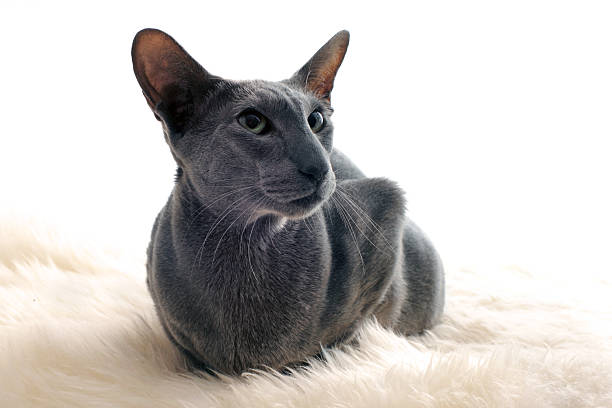
Characteristics
- Origin: Europe/Thailand.
- Physical features: Medium and triangular head, it widens when it reaches the ears. Large, broad-based, prominent ears. Oblique eyes. Long and thin tail.
- Weight: 3 – 6 kg.
- Life expectancy: 12 – 15 years.
- Size/height: 20 – 25 cm.
- Complexion: Slim, medium, muscular, long.
- Hair: Short.
- Weather: Temperate.
- Eyes color: Blue, green.
- Personality: They can be jealous of their owners. They do not tolerate loneliness and they get along perfectly with both children and other pets. They like to climb, jump, and play.
- Health: There are no notable pathologies in this breed except for strabismus.
20. Sphynx
It is also known as the Egyptian cat. Its apparent lack of hair and the fact that it does not have mustaches or eyelashes make it have very particular features
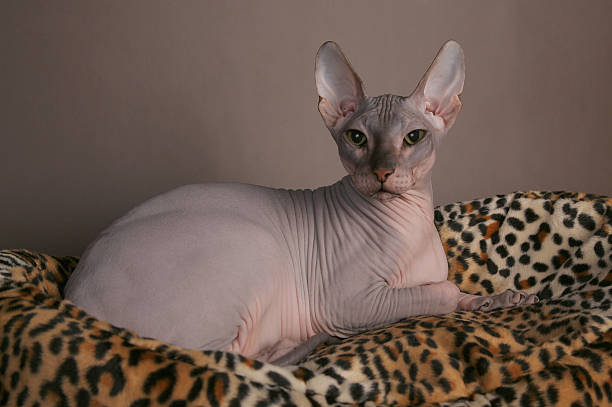
Characteristics
- Origin: America, Canada.
- Physical features: Triangular head, longer than wide with prominent and rounded cheekbones. Ears large and broad at the base. Large, lemon-shaped eyes. Long and thin tail.
- Weight: 3 – 7 kg.
- Life expectancy: 10 – 15 years.
- Size/height: 20 – 25 cm.
- Complexion: Slim, medium, muscular, long.
- Hair: It is so thin that cannot notice.
- Weather: Hot. They do not tolerate the cold.
- Eyes color: Blue, green, yellow.
- Personality: They have a sweet and delicate character and that feel comfortable in contact with people, they are sociable. They get along well with children and other pets. They are curious and playful. They do not like the water.
- Health: This breed is prone to developing contagious diseases through contact with skin wounds such as feline hydrophobia, leukemia, or mange. Hydrophobia, also known as feline rabies, is transmitted by the bite of the infected and is incurable. Going for periodic veterinary check-ups every 6 months is the simplest and most effective way to act in favor of its health. If you observe something strange in its behavior or in its body, do not hesitate to go for a consultation.
Which grey breed is your favorite?
Related Posts
- 25 Fastest Dog Breeds in The World
- 22+ Best Grey Cat Breeds You Should Know
- 19 Most Dangerous Dog Breeds in The World
- 15 Interesting Havana Brown Cat Personality Facts
- How Smart Are Hamsters? (It May Surprise You)
- Can Dogs Eat Mangos?
- Do Dogs Get Tired of Barking? (The Fact May Surprise You)
- Can Dogs Eat Marmite? (Everything You Need To Know)
- 21+ Best Brown Cat Breeds You Should Know
- Want a Pet Lobster at Home? (Know All Facts)
